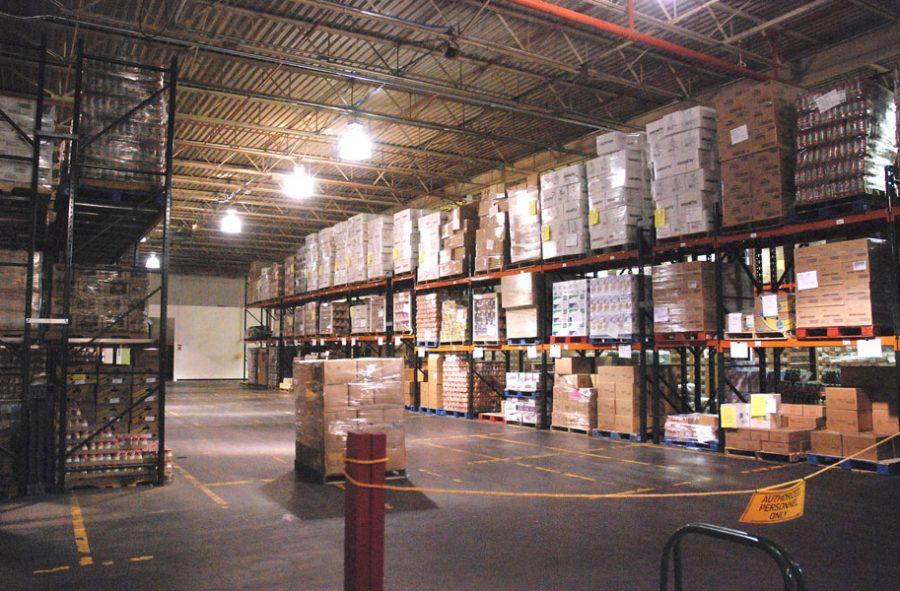Lamoille food bank reaches out to manage hunger in Vermont
nenimedia.creativecirclemedia.com
Vermont Food Bank warehouse in Barre
Over the course of recent years, the food insecurity problem within Lamoille County has risen to where one in four people are struggling to put food on the table.
The most recent census puts the population of Lamoille County at 25,067, which means that approximately 6,266 people are currently contending with this problem.
During January 2017, the Lamoille Community Food Share, a USDA certified food shelf located in Morristown, served 436 families.
For the last several years, the Food Share has seen a steady increase in clients of around nine percent each year. “In 2015, it was 403 [families],” said Sara Babcock, the manager of the Lamoille Community Food Share. “In 2016 it was 427, and 2017 was 436.”
Those numbers come from the six towns that the Food Share is dedicated to serving: Eden, Elmore, Hyde Park, Morristown, Stowe and Wolcott. But the problem of food insecurity is bad enough that they are drawing in people from areas much farther away.
“We’ve seen people from all over. We get them from Hardwick, from Saint Johnsbury, Burke; people wander in and see us,” said Babcock.
According to a 2014 Vermont Foodbank study, “Hunger in America,” there are currently 6,200 individual clients per year in Lamoille County who use the Foodbank and their network partners. There is a margin of error of 2,100 clients on either side, but even taking that number into account, that means that there are still at least 4,100 individual clients per year who use charitable donations as a way to put food on the table.
But what about the individual programs that are independent of the Foodbank? The 436 families that the Lamoille Community Food Share reached this January is made up of 1,537 individuals. Add to that the roughly 120 families that get served by the Johnson Food Shelf and it makes a worrying number.
Presently there are 11 charitable food sites, which range from dedicated food shelves to schools, and even to produce drops. According to the Vermont Foodbank, 277,265 pounds of food were delivered to these 11 food sites. This number takes into account federal programs as well, such as The Emergency Food Assistance Program.
Throughout 2016, the Food Share distributed 143,962 pounds of food, making them one of the largest distributors of charitable food within the county. Bradley’s Community Food Shelf was the next largest food shelf in terms of distribution, with 59,440 pounds of food being distributed.
These are just the numbers of the network partners throughout Lamoille County, not counting The Vermont Foodbank.
Feeding America puts the child food insecurity figure in Lamoille County at a rounded 1,090 as of 2014. That is a 19.8 percent insecurity rate in the population that is under the age of 18. That means that one out of every four children in the county is dealing with food insecurity.
One of the largest causes behind food insecurity across the country is the economy. Housing is too expensive in some places, or jobs are scarce and don’t pay enough, or there’s an unemployment problem.
The “Hunger in America” study for Lamoille County reported 603 households where the person who would be the top earner is currently out of work. This is not to say that these people are not searching for jobs, but that they do not have them and thus are seeking food assistance.
Housing goes hand in hand with the lack of income. Of the people who responded to the survey, 172 had “experienced foreclosure or eviction in the past five years.” An additional 160 people had “lived at least two places in the past 12 months.”
These housing and financial troubles add up until something has to give. Unfortunately for these people, they are often forced to value some critical things over others. They have to choose between paying for food or paying for medical care, housing or transportation; the list goes on.
“There’s basically a food cycle — the broken system that’s happening — whereby people typically are accessing food that’s not healthy because they don’t have enough money,” said Rob Meehan of the Chittenden Emergency Food Shelf. “And . . . that’s causing people to need healthcare, and healthcare is an issue. The cycle continues, where you need medical help, you have limited food, you eat poor food, and you need to go to the doctor. You have to choose between medicine and food, and then it comes back around again to where you’re making bad choices.”
Fortunately, there are multiple programs, meal sites, food shelves and other resources within Lamoille County dedicated to fighting back against food insecurity. There are three separate food shares in Morrisville, two in Jeffersonville, and one in Johnson. Most of those food shares also give out charitable food donations to other towns within the surrounding areas, creating overlap in the county, as well as serving towns in other counties.
One such resource is the Hunger Council of the Lamoille Valley, which meets an average of four times per year. The council is comprised of people who are interested in gaining better food security and was first launched in 2010.
During the June 16, 2016 meeting of the Hunger Council, Scott Johnson from the Lamoille Family Center gave an update on the Breakfast on Us program, which is based out of the First Congregational Church in Morristown. Over the course of 2016, the church was able to serve 3,600 breakfasts, which approximately equates to 30 people per day.
Granted, serving that amount of people is a drop in the bucket of food insecurity, but it is a step in the right direction to providing a solution.
Another healthy solution to food insecurity are farmer’s markets, which offer a healthy alternative to buying junk food for sustenance. One hurdle at these locations is that a good portion are cash only, but there are farmer’s markets in Vermont that accept EBT cards from 3SquaresVt.
An additional problem is transportation to these farmer’s markets, since some of the nearest ones to Lamoille County are located in Essex, or Jericho. If someone doesn’t have transportation to get out to these sites, then they are stuck with eating the food that they can access, which is often not the best nutritional choice.
The Hunger in America study of Lamoille County lists 707 people having reported that they bought cheap and unhealthy food, with another 446 having eaten food that was past the expiration date. Which in turn leads back to medical problems, because a diet of Mountain Dew and Chef Boyardee is dangerous over a long period of time.
“And so we have a greater responsibility to make sure we’re getting the healthy food they want and need,” said John Sayles, CEO of The Vermont Foodbank. “We know, because we do surveys, that the number one and two foods that people want, number one is fresh fruits and vegetables. And number two is low-fat meat and dairy. So we work very hard to have enough of those types of food, and we don’t, but we’ll keep working to have more.”
One of the biggest problems with feeding people at a charitable food site is getting people to show up in the first place. Quite often people are afraid of the stigma of being seen entering a food shelf, and so the services go underutilized.
“Meal sites used to be called soup kitchens, and we’re trying to move away from that,” said Joe Dauscher, the network relations manager of The Vermont Foodbank. “That has the connotation that you’d see during the Depression, people lined up…and they serve a lot more than soup.”
A large concern with the food insecurity problem is feeding the children in Lamoille County who are dealing with food insecurity, also at the county rate of one out of every four. Fortunately, there are programs in place to help children in need, such as free or reduced lunches.
“One is the BackPack Program…we started with three schools that we were doing this in, and it was called the BackPack Program because they would provide backpacks to students that would have food in them for the students to take home and have over the weekend,” said Dauscher. “This is usually on the grade school level, and each year it’s grown. This year we’re up to 27 schools, and we feed 1,250 students each week.”
The BackPack Program operates these days by using a plastic bag, delivered to these schools in totes to be discreetly distributed to the students in need. “Bags of kid-friendly, nonperishable, vitamin-fortified food from all five food groups are packed and distributed to participating schools,” says the page on the Foodbank website. “Guidance counselors, school nurses and other staff identify students in need and send permission slips home to their parents explaining the program.”
At this time, the list of the schools using this program is small, with Morristown Elementary School being the closest to use this program. According to Dauscher, a bag costs approximately $5 to make, which, multiplied over the amount of the students each week, comes out to approximately $6250.
“We always say three things: advocate, donate and volunteer,” said Sayles. “It always surprises me that so many people don’t understand that hunger is an issue, not only in Vermont, but in every county in the country, there are people who don’t have enough money to buy food to eat. And a lot of people are just not aware that’s the case.”




